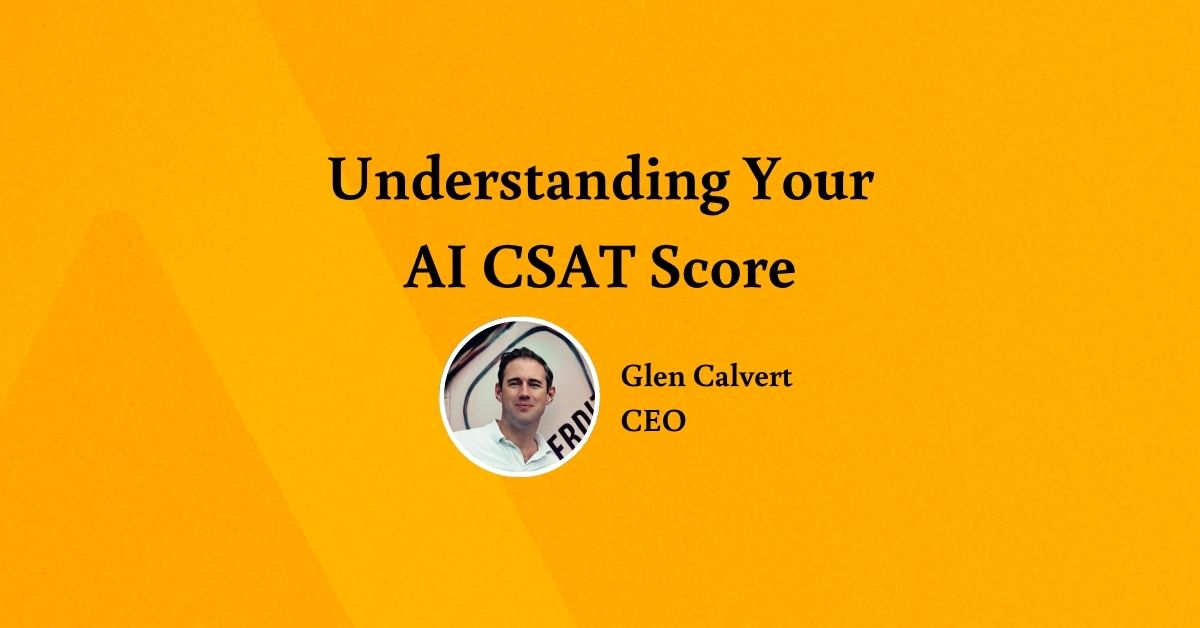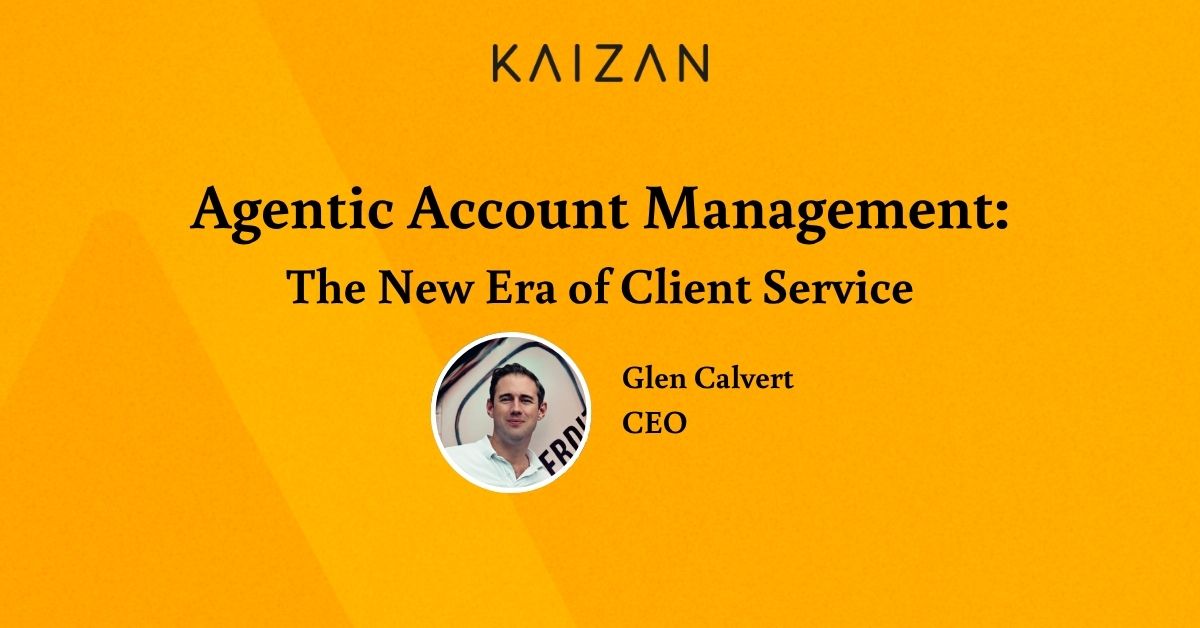The Evolution of NPS & CSAT Surveys

The Evolution of NPS & CSAT Surveys
Why AI‑Generated Relationship Scores Are the Future
Understanding how enterprise clients feel about the service they receive has long been a challenge.
Two of the most widely used customer‑experience metrics — Net Promoter Score (NPS) and Customer Satisfaction Score (CSAT) — were designed for mass markets and straightforward transactions.
However in enterprise relationship management (AKA account management, client service, client success), these surveys are increasingly misaligned with reality. Complex accounts involve multiple stakeholders, objectives and numerous interactions across emails, calls, meetings, chat. Market movements and service ROI also play a key role, while survey response rates are dropping as clients suffer from feedback fatigue.
Here we breakdown the origins, limitations, and evolution of NPS and CSAT Surveys to Kaizan’s AI‑generated satisfaction scores.
Origins of NPS and CSAT
| Metric | Origin | Key Feature |
|---|---|---|
| Net Promoter Score (NPS) | Developed by Fred Reichheld of Bain & Company in 2003 netpromotersystem.com. Introduced to the world through his Harvard Business Review article “The One Number You Need to Grow,” NPS asks customers how likely they are to recommend a company | A simple, single‑question survey. Respondents scoring 9–10 are promoters, 7–8 are passives and 0–6 are detractors. The score is calculated by subtracting detractors from promoters. |
| Customer Satisfaction Score (CSAT) | While companies have measured satisfaction since the early 20th century, formal CSAT measurement gained traction in the early 1990s when the American Customer Satisfaction Index (ACSI) was launched in 1994 helpscout.com. | CSAT asks customers to rate how satisfied they are with a specific interaction or product. The percentage of satisfied customers (e.g., those rating 4–5 out of 5) becomes the CSAT score. |
Both metrics became popular because they promised a simple way to benchmark loyalty and satisfaction.
By 2020 roughly two‑thirds of Fortune 1000 companies used NPS. CSAT surveys are integrated into most help‑desk and CRM systems, and are the most‑used digital customer‑experience metric. Simplicity, however, comes at a cost.
Why NPS and CSAT Struggle in Enterprise Relationship Management
Narrow questions, limited insight:
– Missing context: NPS focuses on the intent to recommend, not actual behaviour, and provides a narrow snapshot rather than a comprehensive view. Even when accompanied by an open‑ended question, it seldom reveals the specific issues driving client sentiment. CSAT typically measures satisfaction with a single transaction, which means it only captures immediate reactions and may not reflect the overall health of a long‑term B2B relationship.
– Overemphasis on extremes: Both NPS and CSAT scores are disproportionately influenced by customers with very positive or very negative experiences. Passives — who make up the majority of respondents — are effectively ignored in NPS scoring. This oversimplification misses nuance and can mask emerging issues.
– Response bias and survey fatigue: Response rates for surveys are often below 10%. This means scores reflect the views of only the most vocal customers. In NPS, some companies tie scores to employee compensation, which can encourage staff to beg for high ratings and distort feedback. Repetitive surveys also lead to fatigue; even NPS creator Fred Reichheld has criticised the over‑use of such surveys.
– Lagging indicators: NPS and CSAT surveys are often conducted quarterly or annually. By the time results are analysed, the relationship may have already deteriorated. The static survey does not reflect the dynamic nature of client sentiment and the probability they’ll grow.
Unsuitable for complex B2B relationships
In enterprise settings there are usually multiple stakeholders with different roles and expectations.
Gartner estimates that a typical B2B buying group involves 6–10 decision‑makers. Surveying only one contact can misrepresent sentiment and cause companies to miss feedback from executives who make the budget decisions. Long procurement and onboarding journeys mean that satisfaction can fluctuate at different stages.
Additionally, B2B clients often interact across multiple channels — emails, calls, chat, face to face, quarterly business reviews — which traditional surveys do not capture.
Cost and resource intensity
Designing, administering, and analysing NPS/CSAT surveys requires time and money. CSAT surveys’ limited context, subjectivity and single‑question approach make it difficult to pinpoint root causes of dissatisfaction.
To glean actionable insights, businesses must conduct follow‑up interviews or supplement the survey with qualitative data, negating the supposed simplicity of the metric.
Introducing AI‑Generated Satisfaction and Relationship Scores – AI CSAT Scores
AI‑driven approaches are addressing the shortcomings of traditional surveys by analysing every interaction with a client — not just those that generate survey responses.
Within Kaizan’s Agentic ClientOS platform, we can utilise conversational intelligence, sentiment analysis, system data and updates, service performance in reports, stakeholder interaction signals and behavioural analytics from all client interactions to infer satisfaction and relationship health in real time.
How AI CSAT works
By training the model to imagine it’s the client and each stakeholder, and feeding it the context of every interaction that’s occurred, and data points that are relevant to understanding the client/vendor relationship, the models can assign a satisfaction score in real-time.
The process generally involves:
1. Capturing interaction data: Kaizan ingests digital communication and conversations from calls, chats, emails to understand each client stakeholders view point.
2. Performing sentiment and context analysis: Models examine tone, keywords, punctuation and conversation dynamics (e.g. objection resolution quality and response time) to assess sentiment.
3. Understanding performance against ROI: Is the client happy with what’s being delivered? This is not only inferred from the conversations but the systems data as well (excel reports, project board updates etc)
4. What’s occurring in their market: The wider context of what competitors and the sector movements are happening will also have a large impact on the clients satisfaction levels of your service.
5. Assigning a satisfaction score (AI CSAT): Based on all of this context, the models can now accurately put themselves in the shoes of your client stakeholders and produce a regular CSAT score from all this signal.
6. Aggregating and surfacing insights: Scores are rolled up by account and over time to highlight trends, benchmark client tiers/type against each other, predict risks or growth opportunities, and suggest next‑best actions.
Implications for B2B Client Service & AI-enabled service delivery
AI‑driven satisfaction and relationship scores (AI CSAT) are particularly suited to enterprise client services because they:
1. Capture the complexity of B2B relationships: Enterprise accounts involve multiple stakeholders and long‑term engagements. AI can track sentiment across all contacts and touchpoints, providing a nuanced picture of relationship health rather than a single number from a lone respondent.
2. Provide continuous monitoring: Instead of waiting for quarterly or annual surveys, AI models update scores after every interaction, allowing teams to spot issues early and intervene before dissatisfaction becomes churn.
3. Enable proactive service: By analysing conversation topics and sentiment trends, AI surfaces specific issues to address. It also predicts likely risk or upsell opportunities, empowering account managers to act proactively rather than reactively.
4. Enhance productivity: As well as Kaizan’s AI summarising meetings, crafting follow‑ups, and providing suggestions, it can now save time producing relationship updates and Red, Amber, Green account scores, so they can focus on high‑value activities.
5. Integrate broader business context: These systems can incorporate market movements, competitor activity with other suppliers, performance reports, product usage trends, contract milestones and financial data to provide the richest real-time view of client satisfaction.
Conclusion
Kaizan’s clients are obsessed with doing great work for their clients and delivering a phenomenal experience.
But NPS and CSAT Surveys have not provided the detail they need to truly understand the experience they’re providing. They revolutionised customer‑experience measurement in the early 2000s by offering simple, easy‑to‑communicate metrics. However their reliance on one‑question surveys, low response rates, and lagging nature make them ill‑suited to modern enterprise relationships and AI powered organisations.
Experts warn that both metrics provide limited insight and oversimplify complex sentiment. In B2B environments with multiple stakeholders and lengthy journeys, survey feedback from a handful of respondents can be misleading and quickly outdated.
We’re proud to revolutionise how client service teams and account managers measure client satisfaction, with real-time AI CSAT scores. By analysing every conversation and interaction, these models deliver complete coverage, real‑time insights, and actionable intelligence. Our clients can now can infer client satisfaction with high accuracy and link it to specific drivers. They also free your clients from survey fatigue and provide deeper context which enables proactive, data‑driven client service.
For enterprise relationship management and client service teams, the future lies not in asking clients occasionally if they would recommend the service, but in listening continuously and intelligently to every interaction.
AI CSAT and relationship scores represent a more holistic, timely, and strategic way to understand and improve client happiness.
We can’t wait to see how this feature evolves.



